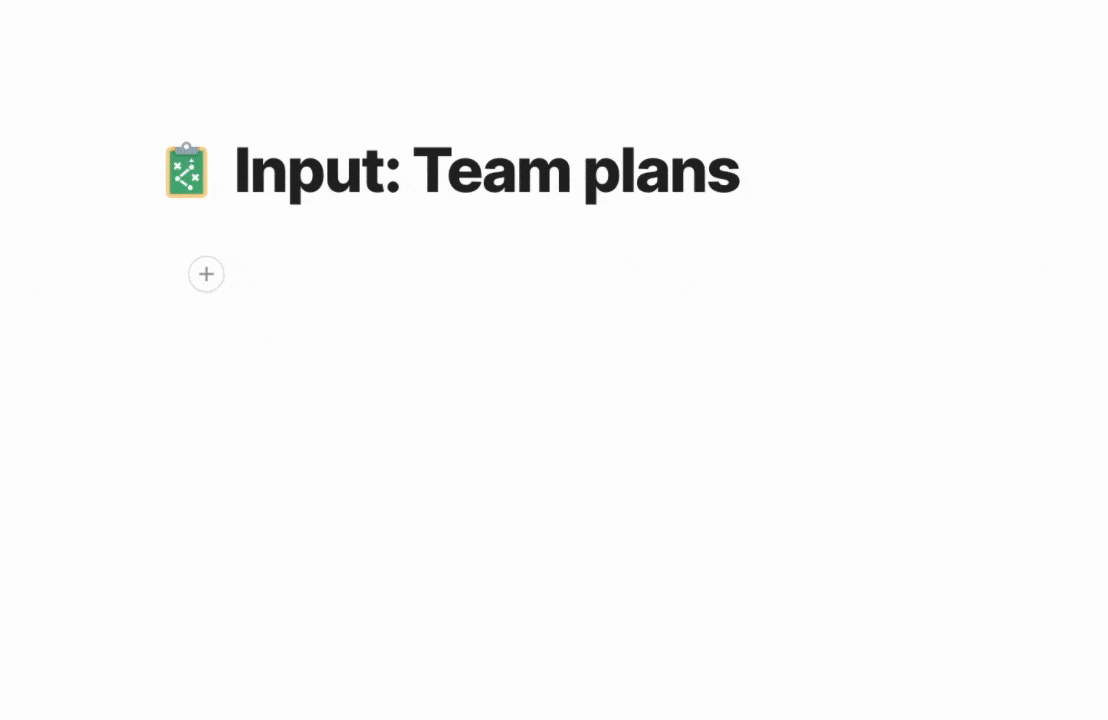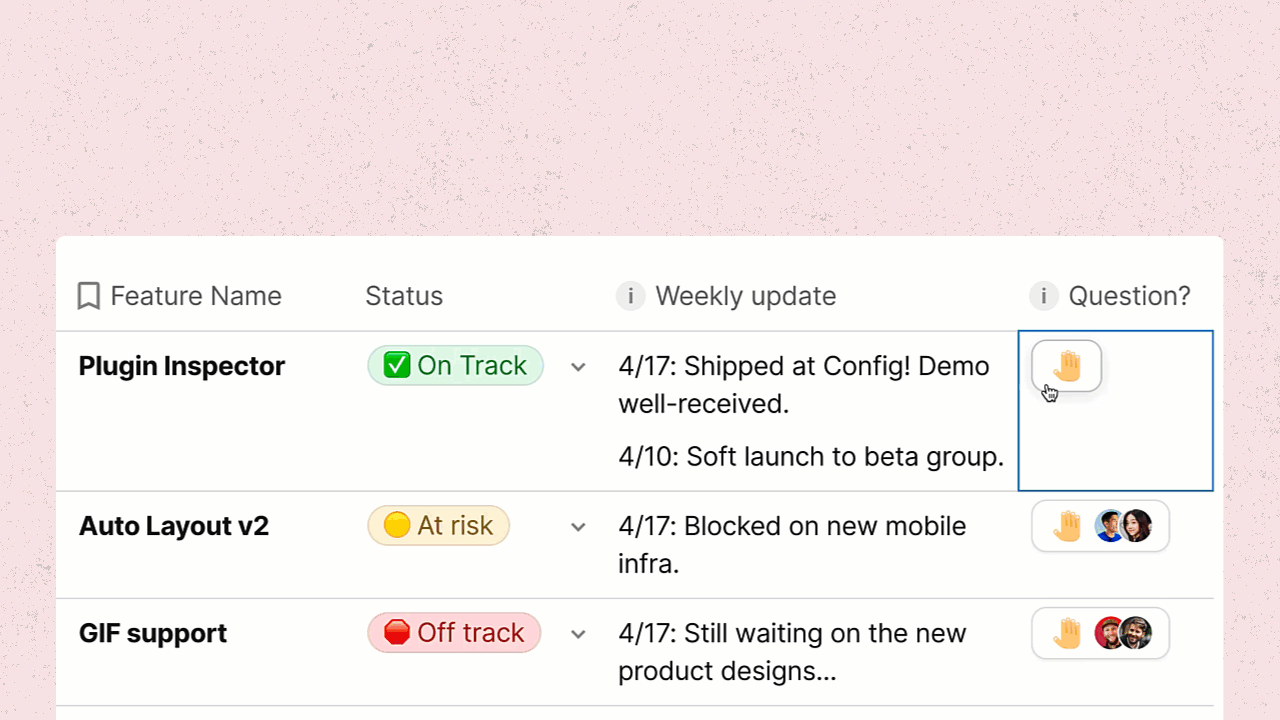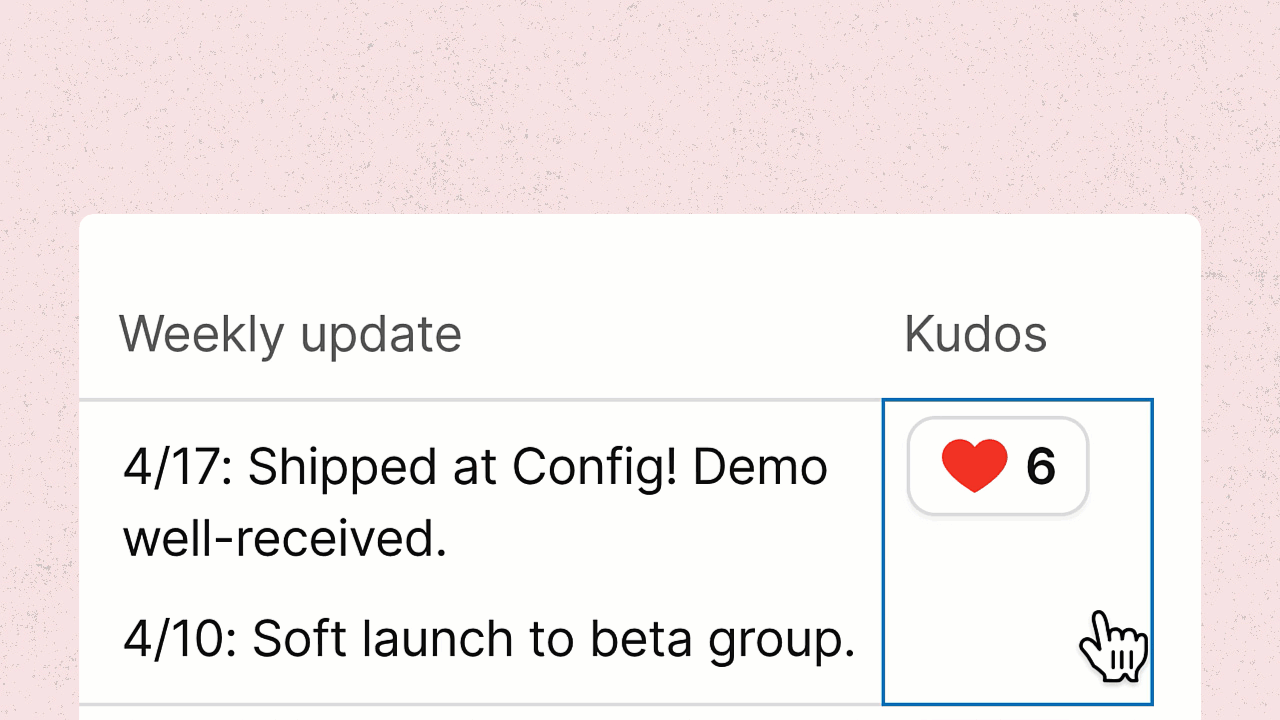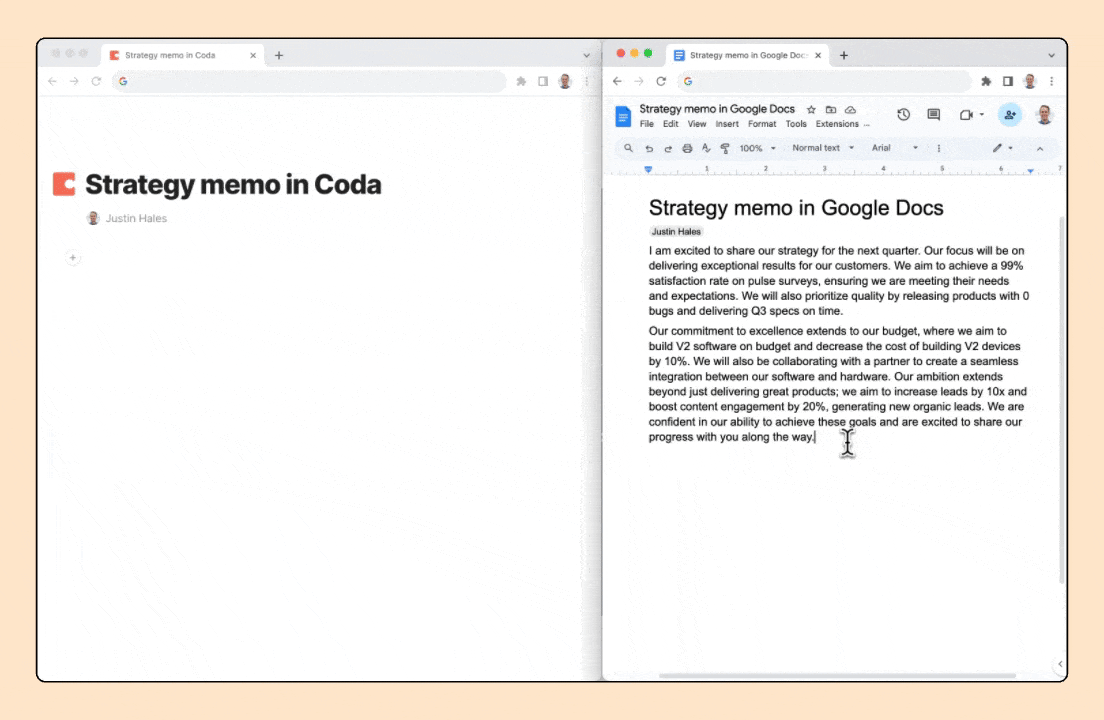Skip to content

Named columns with column descriptions: In Coda you can create named columns like “Objective” or “Key Result.” You can even add clear descriptions of what should go in each column. That makes every downstream action easier. By contrast, in spreadsheets people have to infer what’s in each column by referencing coordinates originally made for accountants, like “A:A” and “C21.” No brittle spreadsheet formulas that break and create chaos: To connect two tables together in spreadsheets, like Objectives and Key Results, you need to use brittle formulas like VLOOKUP and INDEXMATCH. When people break these formulas with copy/paste, you can’t trust the results. In Coda, you can use relation columns that show simple drop-downs for selections. That way you can trust collaborators won’t break your OKRs accidentally.Tables and views, instead of copy and paste: In spreadsheets, collaborators often copy and paste and end up losing data or breaking things. By contrast, Coda has a concept of tables that can have different connected views. That way, when you update a row in one place, it updates everywhere, across all views of that data. This makes creating and updating a set of planning information or OKR data much easier because teams can have views of data built just for their needs.Interactive controls, instead of ambiguous data entry: Have you ever come into a planning or OKR spreadsheet and seen lots of instructions on which cell to update and which to not touch? It’s a very common pattern, but it’s unnecessary and confusing. In Coda, you can create forms and interactive controls that make it easy for your collaborators to enter the data you need to keep the team moving.
One page with wiki-like information about the planning process, timeline, and expectations.One page to capture meeting notes on all planning meetings.One page to set business context, like a note from the CEO or a strategy memo.One page to gather early input, like challenges or key questions to address in planning.One page to run a team input exercise, like $100 voting or planning poker.One page with a output at the end, in the form of a memo and/or OKRs.
Show how strategy is translating into action by adding a filtered table of OKRs that pertain to the strategy you’re discussing above and below.Give clearer context by showing the planning process that led to a big item on the roadmap.Tell the complete story behind each OKR with discussion notes and comments built into each item.
OKR scores and progress.Progress against top customer requests.Team or company metric goals.The ‘why’ or short summary of the vision and strategy.Unlike most dashboards, you can write context around the data. Simply being able to type text next to a live chart is a game changer. That way, it’s easier to make a clear connection between the ‘why’ of what your team is trying to achieve and the data you’re asking everyone to be accountable to.You can integrate it with the execution happening in other docs. That way teams don’t have to double enter or copy/paste data.You can pull in data from 600+ other sources. You can embed dashboards from places like Mode, Amplitude, Mixpanel and others, or sync data directly to the document and user Coda’s native charting capabilities.
They don’t need a meeting.They come from bottoms up.
Theme-based roadmap → (coming soon)
Our source of truth is X tool, how can I integrate that with Coda?What if we’re not in a planning cycle? How should I start?What if I want to integrate a tool that I don’t see listed as a Pack? Other resources related to planning and OKRs topics?

 3. Planning, OKRs & Roadmaps
3. Planning, OKRs & Roadmaps
One place for your whole planning process, that leads naturally to execution.
I asked a customer the other day how many docs, sheets, and presentation artifacts it takes to run their planning process. The answer was familiar but still surprising:
“We have over 200 docs and sheets for our annual planning process... It’s impossible to keep track.”
It was the same story when I worked at Google and YouTube. Everything was spread out, it was a mess.
When planning and OKRs get messy, the results is that teams often aren’t aligned at the end of a planning process. That’s quite literally the opposite goal of planning. A lack of clarity and alignment can kill product velocity.
I’ve become convicted that bringing your planning and execution process together is a simple way to increase a product team’s velocity. Below is an example of how we did this at Pinterest. We worked with their CPO to consolidate dozens of docs, spreadsheets, and presentations into a single source of truth for planning and OKRs. They called it Pyramid OKRs and you can find .


Want to jump ahead?
We’ve created a simple template to jump start your planning discussions using an interactive $100 voting game.
Why product teams centralize planning & OKRs in Coda.
Planning is hard. But a clear planning process that drives alignment and execution can make or break a team and a company. Below are five reasons that your team should try Coda to create better planning outcomes.
1. Planning spreadsheets are brittle, track plans and OKRs in a database.
I’ve seen so many teams default toward planning in spreadsheets for one simple reason: they need a flexible tool so that their planning output can reflect the nuances of their business. That makes sense. But spreadsheets like this often break in fast-paced, collaborative companies. People copy/paste across tabs, reference columns that later change, and before you know it you’re trying to figure out who broke the planning spreadsheet.


With Coda, you get the same flexibility as a spreadsheet without the headache. That means you can create planning, OKR, and resourcing data that reflects your business and specific needs. But unlike spreadsheets, Coda tables are purpose-built for scenarios like this. Specifically:


Loading video: Simple drop downs for selections.mp4...
Loading video: Views keep everything updated.mp4...
Loading video: Interactive controls for planning.mp4...
2. Run your whole planning process in one doc, instead of 10s or even 100s.
One hidden cost of running planning processes and OKRs out of spreadsheets, documents, and presentations is that you get an implicit separation between structured data (spreadsheets) and unstructured data (documents and presentations). You’re forced to choose how to divide your process at the beginning and collaborators are left to piece it all together!
The result is that you likely have a monstrous spreadsheet full of links to documents and planning artifacts. Or emails go out that say things like “Read this doc over here, that corresponds to what’s in this spreadsheet over there, and we summarized it again in this presentation.” I’ve seen dozens of these examples in the wild.
Working this way is exhausting for everyone involved, and frankly unnecessary.


A typical messy planning spreadsheet of links to multiple documents & presentations per team.
With Coda, you can run the whole planning process in a single doc. One doc can have multiple pages (and subpages), which makes it easier to craft a planning process that feels coherent and clear for your teams.
A common pattern for these planning docs is to have:
Here’s an example that we created to mimic M-shaped planning patterns that we see in many of our customers.


Run your entire planning process, from tops-down to bottoms-up, inside a single Coda doc.
3. Create alignment that sticks, twice as fast, & skip the endless discussions.
When it comes to planning, everyone comes with a different lens on the problem and different ideas of what the team should do. But if you’re going to execute, you need some degree of alignment at the end of the process. The more aligned your team is, the stickier your decisions will be, and the faster you’ll execute on your plan.
The failure mode in these cases is to have endless discussions, which demotivate the team and drag out the process. Conversely, the best product teams recognize that the key to alignment is helping their team of the plan. The more your teammates are involved in brainstorming the problems, suggesting solutions, and providing feedback on plans, the more they’ll be aligned with the final output.
Sounds great in theory, right? So why don’t more teams do this?
As I spoke to product teams, I heard the same story over and over. In the hustle and bustle of planning, teams don’t rise to their goals, they . More specifically, the traditional tools teams use to plan — documents and spreadsheets — aren’t designed for driving alignment.
With Coda, you can use the same set of tools from to drive a team toward better alignment. For example, crowdsource problems at the beginning of your planning process with a voting table. Zoom does this in their rituals called .


Brainstorming problems and root causes of problems in Zoom’s RCR doc.
And at the end of your process, enable the team to ask the questions on everyone’s mind with a Dory table.


The end result is better alignment from your team and a faster planning process (often by as much as 2x).
4. Planning output that leads to velocity: Memos, OKRs, & roadmaps together.
Unfortunately, if your team runs a planning process that is fragmented across tools, then it’s likely your planning results will feel fragmented too. It’s like asking a group of people to complete a puzzle on the kitchen table, but then scattering the puzzle pieces in every room in the house. It makes it virtually impossible to reconcile every team’s pieces together into one cohesive picture.
I find most product leaders never think about this because they haven’t seen one tool that can house both structured and unstructured data. In Coda, your plans, strategy memo, OKRs, and roadmap can live together instead of separately. It’s like a single source of truth for the future of your team. That means you can do new things, like:


All of this leads to increased velocity. Individuals on the team can start to fit their work into the larger story of the company. That puts them in a better position to act decisively and attain the goals set out by the team. In my experience, a good planning artifact that combines strategy and OKRs can be transformative for team motivation and execution.
And those puzzle pieces previously scattered throughout the house? With this approach, they are all neatly organized on the kitchen table.
5. Don’t “set and forget” your plans, create systems for accountability.
We’ve all been there. Your team presents an optimistic set of plans at the start of a quarter. Then, two months into the quarter someone asks how the goals are going. And it turns out, the team is behind on most of them.
There are a few different patterns we’ve seen for helping ensure ongoing accountability.
5a. Create the perfect top-level dashboard, and regularly review.
Many of our customers create the perfect dashboard for their team or their company using Coda. Often times it will pull-in things like:


These teams tend to regularly review the dashboard with the company or executive team. The advantages of using Coda to create this dashboard are:
5b. Replace or supplement a meeting with a delightful new approach to accountability.
In an ideal world, we wouldn’t need to use valuable meeting time to drive accountability. But how?
My friend Yuhki, Figma’s CPO, replaced a boring meeting they used to have called the ‘Coordinator Meeting’ with a set of mostly asynchronous processes that he runs out of a doc. He made two key changes.
First, he added a reaction next to every upcoming feature so that anyone could ask a question about it. That way, discussion wasn’t randomized, it could be done synchronously in the meeting or asynchronously in the comments.


Second, he added a button where people could ‘love’ or heart a launch with an emoji. And then something awesome happened, people would click the button a bunch of times. That changed the tone of the entire exercise. It went from boring status updates to people getting support and love for their upcoming work.


Above: Figma’s delightful process for upcoming launches.
5c. Create a system for ongoing asynchronous updates.
Some of the best accountability systems I’ve seen have two traits:
Lyft created one of these systems that they call 3Ps for progress, plans and problems. It’s very similar to a system that I encountered at Google called Snippets. In that system, everyone would input their accomplishments from the past week and say what they were going to do next week. I loved how simple it was, and it still lives on. Back to Lyft, their ritual starts from two core insights.
First, updates and accountability needs to be consistent. So instead of having everyone do team or progress updates their way, they standardize on three points — progress, plans and problems. That way, it’s easy to create and easy to digest across the company.
Second, updates need to relevant to the reader. So the 3P system is built to be personalized, allowing people to subscribe to any initiative and proactively get updates. That way, readers are inundated with things they don’t care about and can focus their attention on what matters.
I love that this system enables ongoing accountability without a meeting!


Lyft’s system for continuous, structured updates and accountability that they call 3Ps.
How to get started with Coda planning and OKRs.
Here are three simple ways to start with the concepts above to improve your planning and execution.
1. Try: run an interactive discussion or creative planning exercise.
One easy way to start is by taking a single planning discussion and considering how you can creatively remake it. The goal could be to make sure all your teammates voices are heard, or to quickly figure out where the team is aligned vs not aligned.
1a. Get structured feedback on an existing strategy memo or presentation.
If you have an existing strategy memo or planning presentation, you can make it more interactive. Try copy/pasting or importing into Coda and adding Dory and Pulse to the bottom of it (). Or simply add a few reactions with prompts like: ‘I think we should do this  ‘ or ‘I don’t think we should do this
‘ or ‘I don’t think we should do this  .
.


1b. Start fresh with a creative planning exercise.
One way to capture the team’s interest and imagination is to get them to put their opinions out there more clearly and express their view of important tradeoffs. Here are two of my favorite planning exercises that can be run at almost anytime during a planning cycle.
$100 voting — you can add problems, or themes, or specific solutions, then let people vote on them. The catch is, everyone gets $100 to spend, so they have to think about how they would allocate their resources carefully. It usually leads to very meaningful discussion as people figure out where to put their money.


Reaction columns provide a fun way to ‘fund’ your team’s priorities with an imaginary budget of $100.
Sentence starters — create your own set of prompts or sentence starters and let people add their opinions. I find this works well early in the planning process when you’re trying to get out some of the raw opinions and insights that will go into planning.


Buttons provide a great way of prompting people to add their input.
2. Customize: Move your existing goals or OKRs into a Coda doc.
If your team already has a set of OKRs in a spreadsheet or other tool, you can or copy and pasting. Once your OKRs are in Coda, then you can create other pages for meeting notes, strategy memos or other important context on your OKRs.


Progress bars and table views make it easy to create exec dashboards that stay up-to-date.
3. Scale: Create a unified planning, execution, and roadmap ritual.
If you’re ready to undertake a bigger change with your team, you can create a more robust planning and execution system. The core insight here is that seamlessly moving from planning to execution and back again helps your team execute faster.
When I talk to other product leaders, they generally have a starting point like wanting to fix a problem with OKRs, or needing a clearer roadmap, or wanting to drive execution closer to customers. So here are a few different ideas how to get started, given those starting points.
3a. If you’re starting with OKRs...
Many planning processes start with the output of OKRs in mind. They might be annual or quarterly but either way, you’re working backwards from landing on a specific and actionable set of objectives and key results. Here are two templates that can help you guide that process.
3b. If you’re starting with a roadmap...
As a product leader, you often need a clearer view of what’s coming next. There are many different patterns of roadmaps, but here are a few that I’ve seen and used myself.
3c. If you’re starting with a workflow for upcoming launches...
I’m a big believer in maintaining a wholistic view of what’s going to ship to your customers. The best way to start is by building a clear calendar of upcoming launches, including a simple launch workflow. From there, you can layer on automations like sending launch summaries to Slack or email, automating requests for updates and automating reminder to reflect on past launches.
3d. If you’re starting with customer feedback...
Some organizations pride themselves on being customer obsessed. These organizations often drive a roadmap directly from customer feedback. This can be helpful, especially early in a product’s lifecycle when finding product-market fit. Here are two templates that I’ve seen be very impactful to customers.
3e. If you’re trying to drive more accountability...
In some cases, product leaders need to drive clearer accountability throughout their organization. I’ve seen a few really clever rituals for creating better paths of communication and accountability that are worth checking out below.
FAQ
There are two main ways to integrate other tools with Coda. The simplest way is . The deeper and more powerful way is by using .
There are two ways. You could create and socialize a lightweight planning exercise to prep for your next planning cycle. Or, you could try importing your goals and OKRs into a Coda table to see how it feels compared to your existing tool.
Check out for a compilation of all the templates and external links mentioned above.
Want to print your doc?
This is not the way.
This is not the way.

Try clicking the ··· in the right corner or using a keyboard shortcut (
CtrlP
) instead.